When I first started making sauerkraut I was totally freaked out by the idea of letting vegetables sit on my counter for a week. And then I was supposed to eat that? I was worried that I would make myself sick or it would mold or taste awful. The reason I even wanted to make it in the first place was purely for health reasons. I read , “The Body Ecology Diet”, by Donna Gates and she stresses that cultured vegetables should be eaten daily to aid in digestion, heal the gut and aid in the absorption of vitamins and minerals. Along with many other benefits. Anyway, I had a hard time finding true step-by-step instructions on how to prepare the cabbage. Reading the recipe wasn’t good enough, because it left me with more questions, like how much salt to add, how to make the brine, what was it supposed to look like after a week, etc. I found some YouTube videos on making it and finally got up the courage to do it myself.
So, I thought a post where I explained step-by-step the method I use to make basic lacto-fermented sauerkraut would be really helpful to you. In this method I will be using mason jars as a fermentation vessel, because they are cheap, easy to find, and most people have them lying around their house these days. This is the bare bones recipe. If this is your first kraut, start here.
- 1 head of green cabbage
- 1 tablespoon of sea salt
- purified water
- Pull 3 outer leaves off of the head of cabbage and set aside. Shred the remaining cabbage in a food processor or mandolin or chop with a knife.
- Place shredded or chopped cabbage in a big bowl and add the sea salt.
- Massage the cabbage with your hands until it breaks down and becomes soft (about 10 min)
- Pack the cabbage in the mason jar tightly, pushing it all the way down until it submerges in its own juices (this is the brine). Leave about 1½ inches of space from the top of the jar. If there is not enough brine to cover the cabbage, add more brine by combining a teaspoon of sea salt with 1 cup of water.
- Roll up the leaves and place them in the jar to push the cabbage under the brine. Screw on the jar loosely so gas can escape as fermentation takes place. Set on the counter for 7 days in a cool, shaded place. During fermentation the sauerkraut will bubble a little and become cloudy. If scum appears, remove it with a spoon.
- Remove the rolled up cabbage leaves and toss in the garbage before eating.
Another note: It is almost impossible to mess up this recipe if you follow my instructions. By keeping the vegetables submerged under liquid, you create an environment where mold cannot grow. If any scum appears, remove it with a spoon. The rolled up cabbage leaves may turn brown or look yucky. Don’t worry, you will not be eating these leaves. Only eat the vegetables that were submerged under the brine.
Variations: The possibilities are endless. You can experiment with purple cabbage, add in carrots, garlic, beets, ginger and any other veggies in different combinations that sound good to you.
Resources:
All Sauerkraut Recipes on Fermented Food Lab
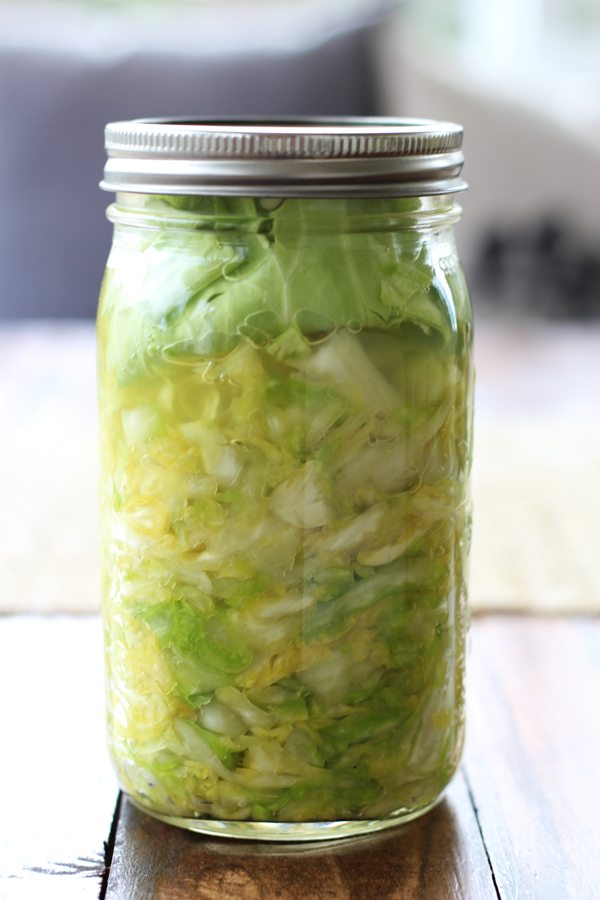
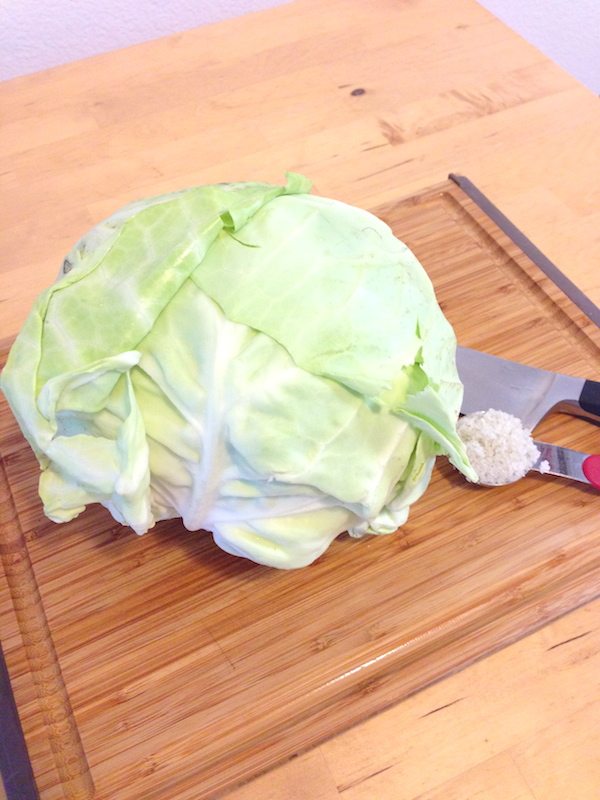
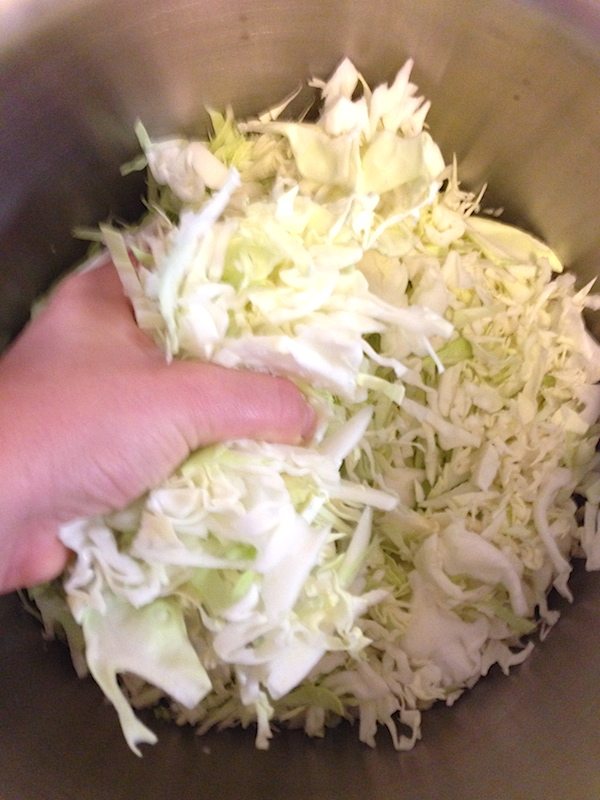
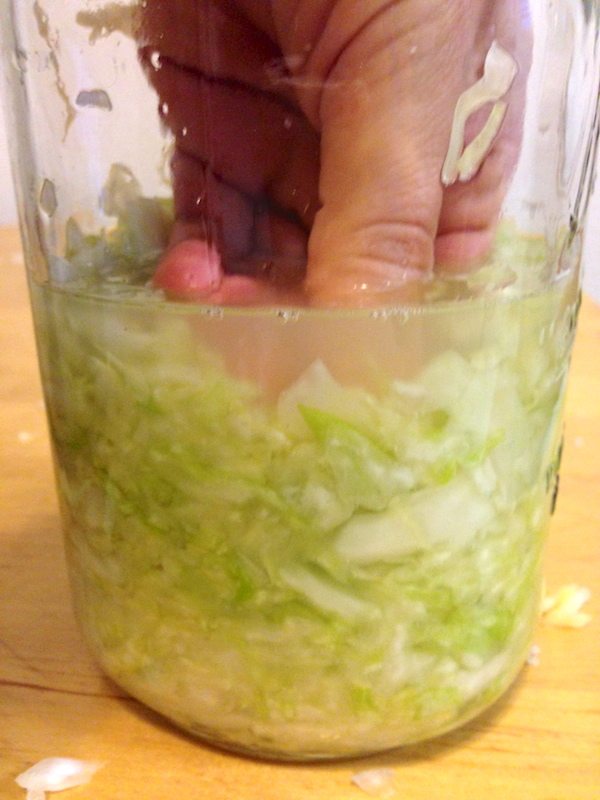
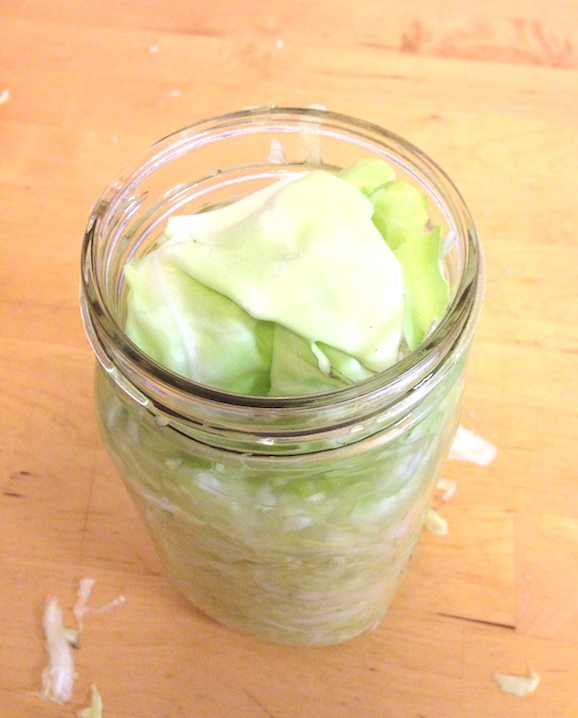
Does it have to be sea salt or can I use others? I normally use kosher salt. Thanks!
Hi Karlie, Yes, you can use kosher salt.
Well…first my cabbage must have been too small ….because it only made one quart jar secondly my shred was smaller than yours so I don’t know if that matters? (mostly cuz I don’t know how to use my food processor) but then when I put the salt on it and started working it..it was foaming all up! Yes, foaming! then I freaked out cuz I had use peroxide or earlier and was worried I got peroxide in my cabbage even though I washed my hands I half a dozen times!
is it supposed to foam?
so it got kind of soft but there’s wasn’t very much brine and so I put some more water in it (I think it’s too salty because that amount of salt was for twice what I ended up with)
and then I abandon it after 2 minutes and put it in the jar because I was like well this is so pointless, its ruined already”!
Hi Christy! The amount sounds right. 1 head of cabbage makes about a quart size jar of kraut. The shred size doesn’t make a difference.
It can get air bubbles as you massage the cabbage and pack it into the jar, but it shouldn’t foam up like soap. You may have soap residue in your bowl or jar.
You can always add a little salt at a time and taste the cabbage mixture throughout the process. It should taste slightly salty.
Here is a video tutorial I made for this recipe. I think this will help. https://www.youtube.com/watch?v=FnV3oLtGZyE
I encourage you to give it another go. It takes a little trial and error to get comfortable with fermenting, but once you’ve made a good batch, you’ll be hooked. Let me know if you have more questions.
thanks for this recipe. I tried this over the summer in a mason jar too. I found a video where they show a guy tamping down the cabbage in the jar. Perhaps you can add something to the written instructions to the effect that pushing down the salted cabbage is what releases the enzyme-laden water that mixes with the salt. I used the technique of I TBS of salt per medium head of cabbage and sprinkling it on the shredded cabbage and then just leaving it alone for a few hours – no massaging necessary. Then you just tamp down the cabbage in the mason jar. The salt brings out the liquid from the cabbage, which creates the brine in the process. Hope this helps
i am on my sailboat in the bahamas ,can i place the jar in the fridge to ferment?thank you!
The fridge is too cold to ferment. It needs to be in a spot that’s 68-80 degrees.